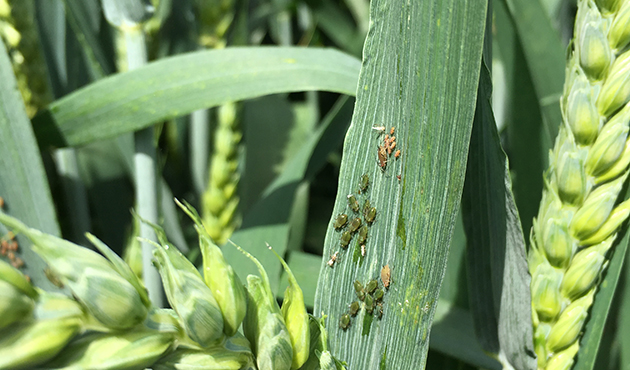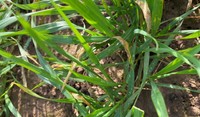
Perfect storm warning for BYDV infections in spring barley

In England, the first aphid migration of the year rarely threatens spring barley, as crops are usually far enough ahead that they have advanced beyond their most susceptible 2-5 leaf growth stage. However, since the start of the year, temperatures have rarely fallen below the minus 5oC needed to reduce aphid populations. And, whilst the majority of spring barley would normally be sown and out of the ground by now, large areas are still to be drilled, leaving a significant potential for aphids to find and infect new seedlings as soon as they emerge.
Flight predictions
The latest modelling work from Rothamsted Research suggests that the first flights of Bird cherry-oat aphid (Rhopalosiphum padi) are predicted to take place in the first half of April in England, with Grain aphid (Sitobion avenae) and Rose-grain aphid (Metopolophium dirhodum) expected to follow soon after.
That’s two to three weeks earlier than normal, with the number of aphids also predicted to be in the top 25% of historical levels. As such, there’s a high risk that barley plants could become infected with the BYDV virus almost as soon as they emerge from the seedbed, with subsequent aphid migrations exacerbating the problem by spreading the virus further into the field.

Grain aphid migration is predicted to start early this year, putting spring barley at increased risk of BYDV infection.
To protect yields, and the potential for crops to attain a malting premium, growers are advised to factor a suitable aphicide treatment into their early season spray programmes.
In Ireland, where the convergence of aphid activity and crop emergence occurs more frequently, yield losses of 0.5-1.0 tonnes per hectare are commonplace in untreated crops, so it’s worth protecting crops from the outset.
Be aphid alert
To find out when aphids are likely to be active in your area, follow the link to the AHDB’s aphid bulletin: https://insectsurvey.com/aphid-bulletin
While this provides a useful guide to highlight when aphids are likely to be in your area, there’s no substitute for getting out in the field to check for the first aphid migration. Only when aphid activity has been confirmed should a suitable insecticide be applied.
Reduced toxicity to beneficial insects
Assuming the aphid population threshold is exceeded, the best line of defence is to apply an insecticide when the crop is at growth stage 13-14. In situations where a pyrethroid pesticide is deemed necessary, MAVRIK® (240 g/litre tau-fluvalinate) not only provides fast-acting contact control of aphids in cereals, but also has a lower residual impact on beneficial insects compared to other pyrethroids.
This reduced toxicity enables populations of advantageous insects such as ground and rove beetles, hoverflies, lacewings, ladybirds and parasitic wasps and flies to recover more quickly after crops have been sprayed, therefore ensuring there’s a strong population of predators ready and able to contribute to the control of any subsequent influxes of aphids. MAVRIK also has the added advantage of being very fast-acting which means it halts feeding damage quickly.
MAVRIK also remains stable at higher temperatures compared to alternative insecticides, with work carried out at BTL Bio-Test Labor Gmbh Sagerheide in Germany showing that temperatures above 15oC reduced the efficacy of lambda cyhalothrin CS formulation against Grain aphids. Meanwhile, aphid knockdown and the persistence of MAVRIK continued to be robust at 20 and 25oC, which makes it the more effective option if and when the mercury finally starts to rise.

Controlled temperature work found Mavrik (green lines) to be more effective against grain aphids compared to lambda cyhalothin (red lines) at all temperatures from 15oC upwards.
Source: T.Thieme, 2017 (BTL Bio-Test Labor Gmbh Sagerheide, Germany)
Treatment decision making
Spring BYDV is not something growers in the UK usually have to contend with. However, this year looks set to be different due to the early anticipated aphid flights and late crop establishment.
The AHDB’s T-Sum modelling tool (see link below) is a good way of determining when crops are at risk and shows that spring crops are likely to reach the 170 day degrees (DD) threshold approximately 10 days after crop emergence, or maybe even slightly sooner.


